View in other NatureServe Network Field Guides
NatureServe
Montana
Utah
Wyoming
Idaho
Wisconsin
British Columbia
South Carolina
Yukon
California
New York
Chryxus Arctic - Oeneis chryxus
Native Species
Global Rank:
G5
State Rank:
S5
Agency Status
USFWS:
USFS:
BLM:
External Links
General Description
[From Ferris and Brown 1981, Scott 1986, Glassberg 2001, Guppy and Shepard 2001, Pyle 2002] Forewing 2.3-2.8 cm. A medium-sized arctic with variable markings; dorsal surface usually bright tawny, male with gray-brown scaling over basal two-thirds of forewing; ventral forewing with at least some orange visible and a "birdbeak" projection pointing outward on postmedian line between first and second of three or four eyespots (also visible from above), ventral hindwing with heavy brown striations and a dark median band sometimes edged with white.
Phenology
Two-year life cycle in some areas. One flight. Mid-May to mid-June in Michigan and central Saskatchewan; late May to mid-July at lower altitude (2400 m elevation) in Colorado, late June to early August at and above treeline (3350 m elevation); mid-July to mid-August above treeline in California; late May to late August in Washington (Scott 1986, Pyle 2002). Mostly in even years in Colorado, odd years in northern Wyoming and California, every year in British Columbia, Michigan and Manitoba (Scott 1986, Guppy and Shepard 2001).
Diagnostic Characteristics
Combination of ventral forewing with at least some orange visible, and a "birdbeak" projection pointing outward on postmedian line between first and second of three or four eyespots (also visible from above), are most distinctive.
Species Range
Montana Range
Range Descriptions
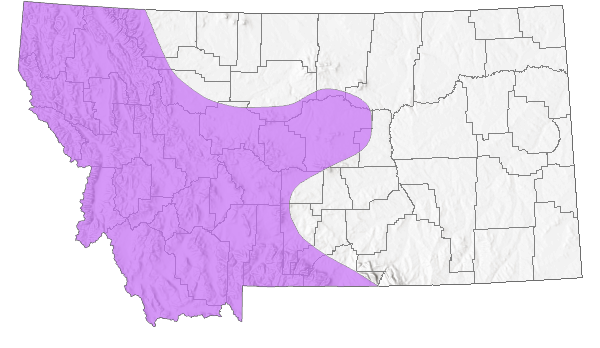
 Native
Native
Range Comments
Boreal regions from Alaska across Canada to Quebec, south in the west through Washington in the Cascades and New mexico in the Rocky Mountains west of the Great Plains, with disjunct populations in the Sierra Nevada of California (Ferris and Brown 1981, Scott 1986). Throughout Montana west of the plains (Kohler 1980, Stanford and Opler 1993). Common to abundant (Glassberg 2001).
Observations in Montana Natural Heritage Program Database
Number of Observations: 8
(Click on the following maps and charts to see full sized version)
Map Help and Descriptions
Relative Density

Recency
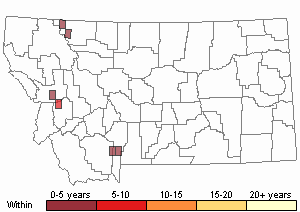
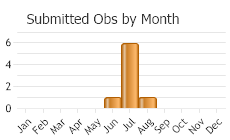
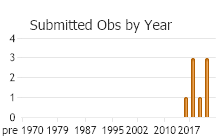
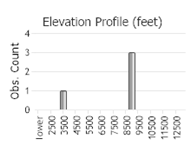 (Observations spanning multiple months or years are excluded from time charts)
(Observations spanning multiple months or years are excluded from time charts)
Migration
Apparently non-migratory.
Habitat
Bunchgrass and sagebrush montane clearings and meadows, open woodland, above treeline in alpine tundra; to at least 3350 m in Colorado (Ferris and Brown 1981, Scott 1986, Pyle 2002). Montane areas to above treeline in alpine terrain in Glacier National Park (Debinski 1993).
Food Habits
Larval food plants include grasses (Danthonia, Festuca, Imperata, Oryzopsis, Phalaris, Poa, Scirpus) and sedges (Carex, Cyperus), some of which were used in captivity (Pyle 2002, James and Nunnallee 2011). Adults feed on flower nectar (including Castilleja, Geranium, Phlox) and sip mud (Scott 1986).
Reproductive Characteristics
Females lay up to 100 eggs singly on grasses and sedges. Number of eggs per ovariole (1/8 of total) about 35 (Ehrlich and Ehrlich 1978). Eggs hatch in about 12-24 days (depending on temperature and subspecies). L1 instar larve overwinter, some populations overwinter a second time as L4 or L5 instars. Reach L5 or pupate in captivity in about 88 days after egg-hatch. Larvae do not construct nests; pupates unattached on ground, adults emerge in 14 days (Pyle 2002, James and Nunnalee 2011). Males mostly perch throughout the day, usually on hilltops or ridge crests but also gulches near treeline, to await females (Scott 1986).
References
- Literature Cited AboveLegend:
 View Online Publication
View Online Publication Debinski, D. 1993. Butterflies of Glacier National Park, Montana. Occasional Papers of the Museum of Natural History, the University of Kansas, Lawrence, Kansas. No. 159: 1-13.
Debinski, D. 1993. Butterflies of Glacier National Park, Montana. Occasional Papers of the Museum of Natural History, the University of Kansas, Lawrence, Kansas. No. 159: 1-13. Ehrlich, A.H. and P.R. Ehrlich. 1978. Reproductive strategies in the butterflies: I. Mating frequency, plugging, and egg number. Journal of the Kansas Entomological Society 51(4): 666-697.
Ehrlich, A.H. and P.R. Ehrlich. 1978. Reproductive strategies in the butterflies: I. Mating frequency, plugging, and egg number. Journal of the Kansas Entomological Society 51(4): 666-697. Ferris, C.D. and F.M. Brown (eds). 1981. Butterflies of the Rocky Mountains. Univ. of Oklahoma Press. Norman. 442 pp.
Ferris, C.D. and F.M. Brown (eds). 1981. Butterflies of the Rocky Mountains. Univ. of Oklahoma Press. Norman. 442 pp. Glassberg, J. 2001. Butterflies through Binoculars: A Field Guide to the Butterflies of Western North America. Oxford University Press.
Glassberg, J. 2001. Butterflies through Binoculars: A Field Guide to the Butterflies of Western North America. Oxford University Press. Guppy, C.S. and J.H. Shepard. 2001. Butterflies of British Columbia: including western Alberta, southern Yukon, the Alaska Panhandle, Washington, northern Oregon, northern Idaho, northwestern Montana. UBC Press (Vancouver, BC) and Royal British Columbia Museum (Victoria, BC). 414 pp.
Guppy, C.S. and J.H. Shepard. 2001. Butterflies of British Columbia: including western Alberta, southern Yukon, the Alaska Panhandle, Washington, northern Oregon, northern Idaho, northwestern Montana. UBC Press (Vancouver, BC) and Royal British Columbia Museum (Victoria, BC). 414 pp. James, D.G. and D. Nunnallee. 2011. Life histories of Cascadia butterflies. Corvallis, OR: Oregon State University Press. 447 p.
James, D.G. and D. Nunnallee. 2011. Life histories of Cascadia butterflies. Corvallis, OR: Oregon State University Press. 447 p. Kohler, S. 1980. Checklist of Montana Butterflies (Rhopalocera). Journal of the Lepidopterists' Society 34(1): 1-19.
Kohler, S. 1980. Checklist of Montana Butterflies (Rhopalocera). Journal of the Lepidopterists' Society 34(1): 1-19. Pyle, R.M. 2002. The butterflies of Cascadia: a field guide to all the species of Washington, Oregon, and surrounding territories. Seattle Audubon Society, Seattle, Washington. 420 pp.
Pyle, R.M. 2002. The butterflies of Cascadia: a field guide to all the species of Washington, Oregon, and surrounding territories. Seattle Audubon Society, Seattle, Washington. 420 pp. Scott, J.A. 1986. The butterflies of North America: a natural history and field guide. Stanford University Press, Stanford, California.
Scott, J.A. 1986. The butterflies of North America: a natural history and field guide. Stanford University Press, Stanford, California. Stanford, R.E. and P.A. Opler. 1993. Atlas of western USA butterflies: including adjacent parts of Canada and Mexico. Unpubl. Report. Denver and Fort Collins, Colorado 275 pp.
Stanford, R.E. and P.A. Opler. 1993. Atlas of western USA butterflies: including adjacent parts of Canada and Mexico. Unpubl. Report. Denver and Fort Collins, Colorado 275 pp.
- Additional ReferencesLegend:
 View Online Publication
View Online Publication
Do you know of a citation we're missing? Allen, T.J., J.P. Brock, and J. Glassberg. 2005. Caterpillars in the field and garden: a field guide to the butterfly caterpillars of North America. Oxford University Press.
Allen, T.J., J.P. Brock, and J. Glassberg. 2005. Caterpillars in the field and garden: a field guide to the butterfly caterpillars of North America. Oxford University Press. Brock, J.P. and K. Kaufman. 2003. Kaufman Field Guide to Butterflies of North America. Houghton Mifflin Company, New York, NY 284 pp.
Brock, J.P. and K. Kaufman. 2003. Kaufman Field Guide to Butterflies of North America. Houghton Mifflin Company, New York, NY 284 pp. Debinski, D.M., R.E. VanNimwegen, and M.E. Jakubauskas. 2006. Quantifying relationships between bird and butterfly community shifts and environmental change. Ecological Applications 16(1): 380-393.
Debinski, D.M., R.E. VanNimwegen, and M.E. Jakubauskas. 2006. Quantifying relationships between bird and butterfly community shifts and environmental change. Ecological Applications 16(1): 380-393. Layberry, R.A., P.W. Hall, and J.D. LaFontaine. 1998. The Butterflies of Canada. University of Toronto Press. 280 pp. + color plates.
Layberry, R.A., P.W. Hall, and J.D. LaFontaine. 1998. The Butterflies of Canada. University of Toronto Press. 280 pp. + color plates.
- Web Search Engines for Articles on "Chryxus Arctic"
- Additional Sources of Information Related to "Insects"





